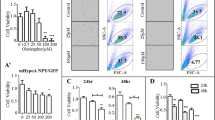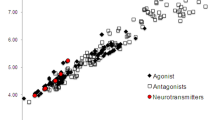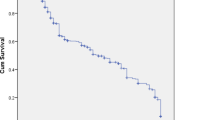Abstract
This study examined the effects of the novel atypical antipsychotic olanzapine (LY170053) on the activity of substantia nigra pars compacta (A9) and ventral tegmental area (A10) dopamine cells in anesthetized rats. Acute administration of olanzapine (10, 20 mg/kg sc) increased the number of spontaneously active A10, but not A9, dopamine cells. Chronic administration of olanzapine (10, 20 mg/kg/day × 21 days) decreased the number of spontaneously active A10, but not A9, dopamine cells. Administration of the dopamine agonist apomorphine reversed the effects of chronic olanzapine on A10 cells, indicating a possible depolarization-inactivation mechanism. In conclusion, olanzapine has selective effects on A10 versus A9 dopamine cells following acute and chronic administration. These effects of olanzapine on dopamine cells are similar to the effects observed with clozapine and may play an important role in the atypical antipsychotic profile of olanzapine.
Similar content being viewed by others
Log in or create a free account to read this content
Gain free access to this article, as well as selected content from this journal and more on nature.com
or
Author information
Authors and Affiliations
Rights and permissions
About this article
Cite this article
Stockton, M., Rasmussen, K. Electrophysiological Effects of Olanzapine, a Novel Atypical Antipsychotic, on A9 and A10 Dopamine Neurons. Neuropsychopharmacol 14, 97–104 (1996). https://doi.org/10.1016/0893-133X(94)00130-R
Received:
Revised:
Accepted:
Published:
Issue date:
DOI: https://doi.org/10.1016/0893-133X(94)00130-R
Keywords
This article is cited by
-
Extrastriatal dopamine D2 receptor occupancy in olanzapine-treated patients with schizophrenia
European Archives of Psychiatry and Clinical Neuroscience (2010)
-
Regional Differences in the Action of Antipsychotic Drugs: Implications for Cognitive Effects in Schizophrenic Patients
Neurotoxicity Research (2010)
-
The Effect of Clozapine on Extracellular Dopamine Levels in the Shell Subregion of the Rat Nucleus Accumbens is Reversed Following Chronic Administration: Comparison with a Selective 5-HT2C Receptor Antagonist
Neuropsychopharmacology (2005)
-
Atypical neuroleptics in child and adolescent psychiatry
European Child & Adolescent Psychiatry (2000)



